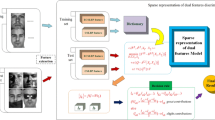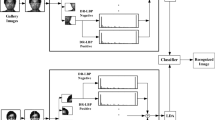Abstract
To investigate the robustness of face recognition algorithms under the complicated variations of illumination, facial expression and posture, the advantages and disadvantages of seven typical algorithms on extracting global and local features are studied through the experiments respectively on the Olivetti Research Laboratory database and the other three databases (the three subsets of illumination, expression and posture that are constructed by selecting images from several existing face databases). By taking the above experimental results into consideration, two schemes of face recognition which are based on the decision fusion of the two-dimensional linear discriminant analysis (2DLDA) and local binary pattern (LBP) are proposed in this paper to heighten the recognition rates. In addition, partitioning a face non-uniformly for its LBP histograms is conducted to improve the performance. Our experimental results have shown the complementarities of the two kinds of features, the 2DLDA and LBP, and have verified the effectiveness of the proposed fusion algorithms.
Similar content being viewed by others
Explore related subjects
Discover the latest articles and news from researchers in related subjects, suggested using machine learning.References
Turk M, Pentland A. Eigenfaces for recognition. Journal of Cognitive Neuroscience, 1991, 3(1): 71–86
Belhumeur P N, Hespanha J P, Kriegman D J. Eigenfaces vs. fisherfaces: recognition using class specific linear projection. IEEE Transactions on Pattern Analysis and Machine Intelligence, 1997, 19(7): 711–720
Ahonen T, Hadid A, Pietikainen M. Face description with local binary patterns: application to face recognition. IEEE Transactions on Pattern Analysis and Machine Intelligence, 2006, 28(12): 2037–2041
Shen L L, Bai L. A review on Gabor wavelets for face recognition. Pattern Analysis and Applications, 2006, 9(2): 273–292
Makwana R M. Illumination invariant face recognition: a survey of passive methods. Procedia Computer Science, 2010, 2(1): 101–110
Murphy-Chutorian E, Trivedi M M. Head pose estimation in computer vision: a survey. IEEE Transactions on Pattern Analysis and Machine Intelligence, 2009, 31(4): 607–626
Wang H, Li S Z, Wang Y. Face recognition under varying lighting conditions using self quotient image. In: Proceedings of the 6th IEEE International Conference on Automatic Face and Gesture Recognition. 2004, 819–824
Zhang T, Tang Y Y, Fang B, Shang Z, Liu X. Face recognition under varying illumination using gradientfaces. IEEE Transactions on Image Processing, 2009, 18(11): 2599–2606
Zhang D, Zhou Z H. (2D)2PCA: two-directional two-dimensional PCA for efficient face representation and recognition. Neurocomputing, 2005, 69(1): 224–231
Noushath S, Kumar G H, Shivakumara P. (2D)2LDA: an efficient approach for face recognition. Pattern Recognition, 2006, 39(7): 1396–1400
Nagesh P, Li B X. A compressive sensing approach for expressioninvariant face recognition. In: Proceedings of the IEEE Conference on Computer Vision and Pattern Recognition. 2009, 1518–1525
Sharma A, Al Haj M, Choi J, Davis L S, Jacobs D W. Robust pose invariant face recognition using coupled latent space discriminant analysis. Computer Vision and Image Understanding, 2012, 116(11): 1195–1110
Lei Y Q, Lai H B, Li Q M. Geometric features of 3D face and recognition of it by PCA. Journal of Multimedia, 2011, 6(2): 207–216
Lei Y Q, Lai H B, Jiang X T. 3D face recognition by surf operator based on depth image. In: Proceedings of the 3rd IEEE International Conference on Computer Science and Information Technology. 2010, 240–244
Lei Y Q, Chen D J, Yuan M L, Li Q M, Shi Z X. 3D face recognition by surface classification image and PCA. In: Proceedings of the 2nd International Conference on Machine Vision. 2009, 145–149
Chowdhury S, Sing J K, Basu D K, Nasipuri M. Face recognition by fusing local and global discriminant features. In: Proceedings of the 2nd International Conference on Emerging Applications of Information Technology. 2011, 102–105
Kim C, Oh J O, Choi C H. Combined subspace method using global and local features for face recognition. In: Proceedings of the IEEE International Joint Conference on Neural Networks. 2005, 2030–2035
Lin D H, Tang X O. Recognize high resolution faces: from macrocosm to microcosm. In: Proceedings of the IEEE Computer Society Conference on Computer Vision and Pattern Recognition. 2006, 1355–1362
Su Y, Shan S G, Chen X L, Gao W. Integration of global and local feature for face recognition. Journal of Software, 2010, 21(8): 1849–1862
Geng C, Jiang X. Fully automatic face recognition framework based on local and global features. Machine Vision and Applications, 2012, 24(3): 537–549
Bai X, Rao C, Wang X G. Shape vocabulary: a robust and efficient shape representation for shape matching. IEEE Transactions on Image Processing, 2014, 23(9): 3935–3949
Zhang M L, Wu L. Lift: multi-label learning with label-specific features. IEEE Transactions on Pattern Analysis and Machine Intelligence, 2015, 37(1): 107–120
Zhang D Q, Wang Y P, Zhou L P, Yuan H, Shen D G. Multimodal classification of Alzheimer’s disease and mild cognitive impairment. Neuroimage, 2011, 55(3): 856–867
Pong K H, Lam K M. Multi-resolution feature fusion for face recognition. Pattern Recognition, 2014, 47(2): 556–567
Cament L A, Castillo L E, Perez J P, Galdames F J, Perez C A. Fusion of local normalization and Gabor entropy weighted features for face identification. Pattern Recognition, 2014, 47(2): 568–577
Tang J H, Li Z C, Wang M, Zhao R Z. Neighborhood discriminant hashing for large-scale image retrieval. IEEE Transactions on Image Processing, 2015, 24(9): 2827–2840
Li Z C, Liu J, Tang J H, Lu H Q. Robust structured subspace learning for data representation. IEEE Transactions on Pattern Analysis and Machine Intelligence, 2015, 37(10): 2085–2098
Li Z C, Liu J, Yang Y, Zhou X F, Lu H Q. Clustering-guided sparse structural learning for unsupervised feature selection. IEEE Transactions on Knowledge and Data Engineering, 2014, 26(9): 2138–2150
Wang D H, Wang X K, Kong S. Integration of multi-feature fusion and dictionary learning for face recognition. Image and Vision Computing, 2013, 31(12): 895–904
Chan C H, Tahir M A, Kittler J, Matti P, Pietikainen M. Multiscale local phase quantization for robust component-based face recognition using kernel fusion of multiple descriptors. IEEE Transactions on Pattern Analysis and Machine Intelligence, 2013, 35(5): 1164–1177
Wang WH, Yang J, Xiao J W, Li S, Zhou D X. Face recognition based on deep learning. Lecture Notes in Computer Science, 2015, 8944: 812–820
Sun Y, Wang X G, Tang X O. Deep learning face representation from predicting 10,000 classes. In: Proceedings of the IEEE Conference on Computer Vision and Pattern Recognition. 2014, 1891–1898
Liu M Y, Li S X, Shan S G, Chen X L. AU-inspired deep networks for facial expression feature learning. Neurocomputing, 2015, 159(1): 126–136
Wang B B, Hao X J, Chen L S, Cui J M, Lei Y Q. Face recognition based on the feature fusion of 2DLDA and LBP. In: Proceedings of the 4th International Conference on Information, Intelligence, Systems and Applications. 2013, 155–158
Ye J P, Janardan R, Li Q. Two-dimensional linear discriminant analysis. Advances in Neural Information Processing Systems, 2004, 17: 1569–1576
Wang X M, Huang C, Fang X Y, Liu J G. 2DPCA vs. 2DLDA: face recognition using two-dimensional method. In: Proceedings of the International Conference on Artificial Intelligence and Computational Intelligence. 2009, 357–360
Yu W X, Wang Z Z, Chen W T. A new framework to combine vertical and horizontal information for face recognition. Neurocomputing, 2009, 72(4): 1084–1091
Samaria F S, Harter A C. Parameterisation of a stochastic model for human face identification. In: Proceedings of the 2nd IEEE Workshop on Applications of Computer Vision. 1994, 138–142
Lee K C, Ho J, Kriegman D J. Acquiring linear subspaces for face recognition under variable lighting. IEEE Transactions on Pattern Analysis and Machine Intelligence, 2005, 27(5): 684–698
Xu C H, Tan T N, Wang Y H, Quan L. Combining local features for robust nose location in 3D facial data. Pattern Recognition Letters, 2006, 27(13): 1487–1494
Sim T, Baker S, Bsat M. The CMU pose, illumination, and expression (PIE) database. In: Proceedings of the 5th IEEE International Conference on Automatic Face and Gesture Recognition. 2002, 46–51
Stathopoulou I O, Tsihrintzis G A. Appearance-based face detection with artificial neural networks. Intelligent Decision Technologies, 2011, 5(2): 101–111
Author information
Authors and Affiliations
Corresponding author
Additional information
Qicong Wang received the PhD degree from Zhejiang University, China in 2007. He is currently an associate professor at the Department of Computer Science, Xiamen University, China. His research interests include pattern recognition, machine learning and computer vision.
Binbin Wang received the BE degree and the ME degree in 2010 and 2013, respectively, both from Xiamen University, China. She is currently a software engineer at the center of software development of Industrial and Commercial Bank of China, Guangdong.
Xinjie Hao received the BE degree and the ME degree in 2010 and 2013, respectively, both from Xiamen University, China. He is currently a postgraduate student majoring computer science at Worcester Polytechnic Institute, USA. His research interests include machine learning and image processing.
Lisheng Chen received the BE degree and the ME degree in 2010 and 2013, respectively, both from Xiamen University, China. He is currently a technical manager at the department of Internet products of Hebao Financial Information Consultant Co. Ltd., Shenzhen, China.
Jingmin Cui received the BE degree and the ME degree in 2010 and 2013, respectively, both from Xiamen University, China. She is currently a system analyst (SA) at the Research and Development Center (Shenzhen), the Bank of Communications, China.
Rongrong Ji received the PhD degree from Harbin Institute of Technology, China. He had been a Postdoctoral Research Fellow in Columbia University, USA. Currently he is a Minjiang Chair Professor of Xiamen University, China. His research interests include machine learning and computer vision.
Yunqi Lei received the BE degree from the University of Science and Technology of China, China in 1982, and the PhD degree from the National University of Defense Technology, China in 1988. Currently, he is a professor at the Department of Computer Science, Xiamen University, China. His research interests include machine learning and computer vision.
Electronic supplementary material
Rights and permissions
About this article
Cite this article
Wang, Q., Wang, B., Hao, X. et al. Face recognition by decision fusion of two-dimensional linear discriminant analysis and local binary pattern. Front. Comput. Sci. 10, 1118–1129 (2016). https://doi.org/10.1007/s11704-016-5024-6
Received:
Accepted:
Published:
Issue Date:
DOI: https://doi.org/10.1007/s11704-016-5024-6




